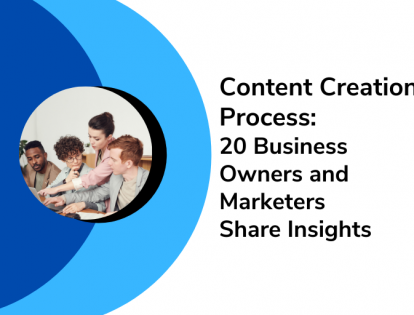Building a content creation process to create high-quality and valuable content is a complex and demanding process. Staying organized is the need of the hour if you want your content process to be streamlined and efficient. We asked businesses and content marketers how they are managing these complexities to create content that delivers results.
To be more precise, we asked them these 3 questions (and amazing insights followed):
- What kind of content do you create and for what purpose?
- What does your content creation process look like? What tools do you use to streamline it and make it efficient?
- What makes your content creation process work (some tips and tricks)?
TL;DR – Content Creation Process – Key Insights
- You need a well-defined content process to create quality content consistently.
- It’s no longer possible to manage content processes on documents, sheets and emails alone. You need specialized content collaboration and project management software.
- Understanding your audience is crucial before getting started with content creation.
- Staying flexible with your content plans and calendars becomes important if you want to accommodate new trends, events or ideas.
- Constant and timely communication with the team is an important factor for a successful content creation process.
Quotable Quotes on Content Creation Process
“A well-defined content creation process can help you generate great content for your business that helps to educate and convert customers.” – Mia Naumoska
“The key to great content, regardless of whether the goal is marketing or entertainment, is to understand your narrative.” – Gerald Lombardo
“An outlined strategy makes you stick to the original structure of the content and don’t get sidetracked.” – Katherine Brown
“We use content management systems keep our content organized and save loads of time in our day.” – Savannah Scott
“The best tip that I can offer any team: stay extremely organized” – Marquis Matson
This is what the 20 business owners and marketers had to say:
1. Nathan Sebastian, Content Strategist and Marketer at GoodFirms
 What kind of content do you create and for what purpose?
What kind of content do you create and for what purpose?
As a B2B review and research platform, our website is entirely content-centric. From having eBooks to research papers, whitepapers to social media content, we practically ride on the power of content. Then there are more than 30,000 text and video reviews from authenticated customers on a broad spectrum of service companies and software.
Our main objective is to help millions of B2B tech companies to discover and promote software products & services. We regularly conduct research & surveys on the industry’s latest trends & technologies so that entrepreneurs can make an informed decision and find the right business aide.
What does your content creation process look like? What tools do you use to streamline it and make it efficient?
Our content creation process includes keyword research, ideation, visuals, collaboration, writing/editing/rewriting, publishing, networking, updating past content, and so on.
We use tools like Keyword Explorer, Site Explorer and Content Gap section in Ahrefs for SEO and competitor research. A detailed analysis gives us an accurate idea of unique keywords we can target and keywords our competitors are ranking for, among other valuable information.
HARO is a tool we use to find contributors with the right expertise to add depth, perspective, and legitimacy to our long-form content.
Then, we love Grammarly, of course – the full paid version – to fix wordiness, vagueness, vocabulary, and sentence structure mistakes. However, one has to add a pinch of common sense while sorting through their recommendations. Knowing your grammar rules certainly helps you override the incorrect suggestions.
We create unique images using Adobe Lightroom alongside Photoshop as a cutting-edge tool with advanced design features. Wondershare Filmora, with its modern intuitive, and user-friendly interface, allows us to create and edit informative videos. GIFs are the least used visuals in our content. Yet, we use Adobe After Effects with Photoshop to create high-quality, custom GIFs whenever the need arises.
What makes your content creation process work (some tips and tricks)?
We are laser-focused on improving quality, relevance, and consistency with each piece of content. And, it goes without saying that visual content is essential to break the wall of text and increase your followers, likes, and shares.
2. Mia Naumoska, Chief Marketing Officer at Chanty
 What kind of content do you create and for what purpose?
What kind of content do you create and for what purpose?
We at Chanty, create a lot of content for our blog around the topics of productivity, teamwork, communication, and collaboration.
What does your content creation process look like? What tools do you use to streamline it and make it efficient?
Our content creation process is fairly straightforward. The first and the most important step is to understand what is the goal that we are trying to achieve with each piece of content published on our platforms. For example, simple goals could be driving traffic to the website, attracting a new audience, or lead generation.
Once we have our goals in place we start researching topics that resonate well with our audience. Keyword research is the most important part of the process. This helps us identify the search volume for a particular word. Then we move on to writing the content and creating the illustrations for the blog. When the final piece is edited it is ready to be published.
What makes your content creation process work (some tips and tricks)?
A well-defined content creation process can help you generate great content for your business, that helps to educate and convert customers.
3. Dhiraj Nallapaneni, Content Marketing Specialist at CryptoTrader.Tax
What kind of content do you create and for what purpose?
I create blog content for CryptoTrader.Tax. We’re a crypto tax reporting software with more than 30,000 paying customers. I write blogs so our company can get more search traffic and ultimately, more leads. We’ve found that organic search is an awesome source of free marketing for our company.
What does your content creation process look like? What tools do you use to streamline it and make it efficient?
The first thing that I do is to find a keyword related to our business that has a high volume of search traffic.
Then, I look at the content that’s already ranking for that keyword. This helps me understand what searchers are looking for and gives me an idea of what we could do to make our content stand out from the competition.
After that, I usually write an outline for the article. It contains ideas for how we can make our article the BEST piece of content for the target keyword.
I’ve found that one powerful way to differentiate our articles is through infographics. Since crypto taxes can be difficult to understand, an infographic that explains a concept in simple terms can be extremely helpful for our audience.
Then, I’ll spend around 1-2 weeks actually writing the article. After it’s done, I give it to my boss to proofread and provide feedback.
We use a design agency called Hatchly that gives us infographics on-demand, based on instructions provided by our team. You can see some examples of how these turn out here – https://cryptotrader.tax/blog/axie-infinity-taxes.
We also use Ahrefs to find keywords that our target customers are searching for and see which blogs are driving the most traffic for our competitors.
What makes your content creation process work (some tips and tricks)?
My biggest tip for businesses that want organic search traffic is before you start writing, write down your plan for how your piece is going to be the BEST content out there for a specific query.
Remember, there are only 10 slots on the first page of Google search results. Google has assembled some of the world’s smartest people to give searchers the best results for every keyword imaginable. If you’re not writing the best content, there’s a very low chance that you’ll be discovered in organic search.
There are multiple ways that you can approach this. Maybe you can give unique advice based on your own personal experience with the topic. Perhaps you could break down a difficult concept with an easy-to-understand infographic.
If you can’t think of any ways to make your content the best, it might not be worth your time to write the piece at all.
4. Petra Odak, Chief Marketing Officer at Better Proposals
What kind of content do you create and for what purpose?
We create two different types of content – we cover our blog with SEO-friendly content made to attract more organic traffic. On the other hand, we also write guest posts to support our blog content with new backlinks.
What does your content creation process look like? What tools do you use to streamline it and make it efficient?
It’s fairly simple. We use Jira for project management and our SEO manager assigns a topic with a brief and a keyword. From that point on, the writer gets down to work. Once done, they return it to the SEO manager to review and make changes.
What makes your content creation process work (some tips and tricks)?
What makes our process work is the fact that our writers edit each other’s work once completed, before turning it in to the SEO manager. This is a great quality assurance check that makes it easier to produce great pieces faster.
5. Andrea Jones, Content Strategist at Onlinedrea
 What kind of content do you create and for what purpose?
What kind of content do you create and for what purpose?
We create a variety of content for our clients. Right now, vertical video on TikTok, Instagram (Reels), YouTube (Shorts), and Pinterest (Idea Pins) is dominating the feeds. It’s important for brands to show up where audiences are already paying attention so that their content gets the maximum exposure. We co-create a combination of content that speaks to the different stages of the customer journey. Social media is typically the top or middle of the funnel. So, much of our content is geared towards building up trust and like-ability with potential clients and customers.
What does your content creation process look like? What tools do you use to streamline it and make it efficient?
We start everything with a strategic plan, generally outlined in a Google Doc so that we can edit and update as we grow. We love using AirTable to plan out our content as it helps keep things very organized and makes it easy to collaborate with writers, designers, video editors, and more. Then we use a combination of Sendible and the native scheduling tools to ensure content goes live at strategic times.
What makes your content creation process work (some tips and tricks)?
We don’t work too far in advance! One thing the past 18 months have taught us is that businesses MUST be flexible and stay up-to-date with current events. We plan key campaigns and dates on a monthly basis, but we do not work on any specific assets until about 10 days prior to posting. We’re on a rolling weekly basis when it comes to content creation so that there’s room to be flexible, should anything happen that requires us to quickly pivot.
6. Jared Pobre, Co-founder at Caldera + Lab
 What kind of content do you create and for what purpose?
What kind of content do you create and for what purpose?
Our content invites customers to join us on our journey to a more sustainable lifestyle. We educate them on the small steps we all can take every day to make a difference, including our choices on things like eating local and buying sustainable products. And that these little steps add up towards making a significant impact on our environment.
Our content about our best-in-nature ingredients and sustainable business practices show customers that our products are not just good for their skin but are made in a way that reduces our carbon footprint. Through our informative step-by-step how-to guides and engaging videos, they learn how to benefit the most from our skincare products.
We’re also working on using AI to optimize product quantities personalized to each customer’s needs. This way, our customers won’t waste any of their purchased skincare, and we further reduce our footprint. By helping our customers learn to make each purchase count, we’re taking them on our mission to help create a clean and healthy world for generations to come.
What does your content creation process look like? What tools do you use to streamline it and make it efficient?
We have an organic content creation process. Social media evolves at the speed of light. So, rather than trying to keep up with trends, we prefer to stay authentic to our brand. Creating genuine long-form content that our subscribers want to share increases our following.
SEO tools like Rank Tracker by Ahrefs help us monitor the progress of the keywords we use on our website. It shows us if the keywords are helping us rank higher on search engine results pages (SERPs) based on the organic traffic they drive to our site. With data from keyword metrics, we can identify which on-page SEO strategies are working and which need to be optimized, making it an excellent tool for A/B testing. We can also study the SERP position history of our competitors and the popular keywords they rank for. If they start outranking us for a specific keyword, we know we need to implement a more aggressive keyword strategy by publishing more content or running a social media campaign.
What makes your content creation process work (some tips and tricks)?
We know this because our followers love watching the long-form videos we post on how we wild harvest the botanical ingredients for our organic skincare products, as well as the fun and informational reviews from our community members. And we love sharing videos of us outside having fun in the surreal beauty of the Wyoming landscape. With the thousands of views, likes, and shares we receive on our videos, we’re going to keep delivering what our audience enjoys. Our long-form videos enable us to create more authentic connections with our customers.
7. Harriet Chan, Co-Founder at CocoFinder
 What kind of content do you create and for what purpose?
What kind of content do you create and for what purpose?
At CocoFinder, we create content for our blog, social media channels, and guest blogs. The focus of our content creation is teaching our target audience about how our search engine can benefit them and their businesses.
What does your content creation process look like? What tools do you use to streamline it and make it efficient?
Our content creation process starts with feedback collection from our visitors through questionnaires and analyzing queries posed to our customer support. Collaboration tools such as Google Docs and keyword research tools like Google Analytics are invaluable in making our content top-notch.
What makes your content creation process work (some tips and tricks)?
The glue that allows all this to work together is seamless collaboration and continued feedback collection. We are also constantly researching longtail keywords that make our content stand out in search engine results.
8. Katherine Brown, Founder at Spyic
 What kind of content do you create and for what purpose?
What kind of content do you create and for what purpose?
Marketing videos and advertisement posters are the kind of content I create. These are purposed towards reaching a target audience and promoting awareness about a product or service to them.
What does your content creation process look like? What tools do you use to streamline it and make it efficient?
Understanding my content’s intended purpose and target audience is the first stage in the content creation process. This is followed by a strategy or plan on the structure of the content which includes, for example, a sketch or acquiring necessary graphic materials. Actual creation and editing of the content is the next step, after which I request a peer to help review it before I publish.
I use the premium versions of Adobe Premiere Pro (for marketing videos) and Adobe Photoshop (for advertising posters) to streamline the creation process and create impactful content.
What makes your content creation process work (some tips and tricks)?
Understanding the target audience works to create suitably tailored content that captures the essence and imprints itself in their memory. An outlined strategy makes you stick to the original structure of the content, so you don’t get sidetracked. Developing and adding different ideas during the creation can cram up the content and make it look messy. Sketches clear out your thought process and help create a flow, while peer reviews are likely to point out something you missed or suggest a tweak.
9. Savannah Scott, Content + Editorial Lead at SuperGreat
 What kind of content do you create and for what purpose?
What kind of content do you create and for what purpose?
At Supergreat, we offer a user-generated video platform for the beauty community so people can connect to share products, reviews, and tips. Essentially, we’re using product reviews as our content because potential buyers visit us to listen to what our community is saying, posting, and sharing. Brands featured on our platform have seen their products sell out in seconds. Reviews are a powerful force driving our social media marketing.
What does your content creation process look like? What tools do you use to streamline it and make it efficient?
As our content is user-generated, its creation is in the hands of our community members. However, we have integrated shoppable live-streaming this year, to further engage and reward our enthusiastic community. Since our founding in 2018, we grew our platform by 300%, integrating shoppable live-streaming in 2021.
What makes your content creation process work (some tips and tricks)?
Staying on top of the content process for your brand’s social media channels can be time-consuming and sometimes confusing when you’re running multiple campaigns. So we use content management systems and social media management tools that support a range of social media networks. This way we can schedule, monitor, and analyze our posts and reviews from one place. Using the content calendars, we can schedule to publish content over time and across all of our platforms. Social media tools also allow us to keep track of comments from multiple channels and respond from one inbox. These tools keep our content organized and save us loads of time in a day.
10. Laura Rike, Freelance Pinterest Manager at Laura Rike
 What kind of content do you create and for what purpose?
What kind of content do you create and for what purpose?
We primarily create blog posts, but I also often include live videos or other videos, podcast episodes, and case studies from our clients. The main intention of our blog posts is to establish expertise and get our clients to trust us by adding value for them.
What does your content creation process look like? What tools do you use to streamline it and make it efficient?
We start with our goals first and decide what to work with and what to do. One of the most important parts of our process is actually the distribution because even the best content is useless if no one sees it!
What makes your content creation process work (some tips and tricks)?
I think the best tip I have is to use Pinterest to make sure people see the content.
11. Rahul Mohanachandran, Co-Founder at Kasera
 What kind of content do you create and for what purpose?
What kind of content do you create and for what purpose?
We create two types of content and the main one has staged images of furniture and other home decor products. These are the products from the retailers and brands we partner with. We post this on our social media daily. The purpose of this content is to provide inspiration for people who are looking for a home decor idea/product and drive sales for the brands we partner with. We also create demo videos of products from our partners and post them on Youtube.
What does your content creation process look like? What tools do you use to streamline it and make it efficient?
Our typical content creation process includes a content calendar at its heart and a posting schedule. This requires a number of different content sets created, taking into consideration how often we repeat a post, the hashtags we use, and the visual element of how adjacent photos look on channels like Instagram.
We use a number of tools for our content creation process and one we rely on the most is Later. It helps us manage our creatives and schedule the content calendar. It also makes collaboration easier for our team members. For video editing, we use the Movavi Video Editor tool which is a very simple but powerful tool.
What makes your content creation process work (some tips and tricks)?
The scheduling and proactive approach is something that helps us create content regularly. But when needed, we never shy away from updating our scheduled content with current events. Whether it is a sporting event, a change in weather, or something else that needs our attention.
12. Julian Goldie, Owner of Goldie Agency Inc.
 What kind of content do you create and for what purpose?
What kind of content do you create and for what purpose?
We are mainly into backlinking, vlogs, blogs, and graphics. Since our clientele is varied, the topics can be anything. The purpose is to get a high rank, organically, on search engines for our clients.
What does your content creation process look like? What tools do you use to streamline it and make it efficient?
We have separate teams consisting of two to three members who oversee the tasks they’re assigned. To ensure the highest quality possible, I have set up two string tests for all the content created before final delivery. One is conducted by the project manager and one is conducted by myself – to ensure that our content creation team is also not left without any support, we have provided them with basic tools (e.g. grammar checker, image quality checker, format checker, etc.) so that they can produce the best end-result which requires minimal to no editing.
What makes your content creation process work (some tips and tricks)?
It’s the flexibility! Trust me, in these days of hybrid workforces, being flexible till the end with your employees brings out the best in them, and eventually, in your business.
Technical support also plays an important role in making our content creation process work smoothly. But for me, being flexible – especially with my remote employees, is the best thing that has happened to them.
13. Molly Ploe, Senior Marketing Specialist at Brafton
 What kind of content do you create and for what purpose?
What kind of content do you create and for what purpose?
I primarily create written content, which is used in a number of ways. Sometimes they’re articles that live on the blog, so their purpose is to earn organic traffic as well as to fill up our weekly newsletter. Written content can also be incorporated into marketing emails, which is used to nurture leads or share relevant content with our email community of marketers. Additionally, I’ve also turned written content into video content. With this, I try to capture more people through channels like YouTube or cater to those who may be more inclined to consume educational content in that format rather than plain text.
What does your content creation process look like? What tools do you use to streamline it and make it efficient?
The content creation process typically begins with a topic, and with SEO content, that means choosing a target keyword. We use tools like Semrush, Moz, and Ahrefs to analyze keywords for difficulty, search volume, and search intent.
Then, we research the topic, not because it’s unfamiliar to us, but rather to see what types of content are already being served to the audience. This helps us ideate on the content format (such as if a video or infographic would be appropriate) as well as subtopics to learn about the range of questions and concerns our audience may have about the topic. To do this research, we use tools like MarketMuse or Clearscope for a TF-IDF analysis, which gives us a long list of suggested terms to include in the content. We also use Google search to analyze the current results page.
Finally, we create the content. We typically use Google Docs for the actual writing process because it’s easy to collaborate with others, ask questions and give quick feedback that everyone can see. We also use our own Content Marketing Platform to coordinate and plan with other teams, like our video production or graphic design teams. This keeps everyone on the same page, ensuring nothing gets lost and everyone can find the assets they need.
What makes your content creation process work (some tips and tricks)?
A couple of key aspects of our content creation process, and the advice I’d give to others, is first to keep an open mind about your topic directions.
Exploring a new format can be fun and give you access to a new segment of your target audience.
Next, I’d say, don’t be afraid to try something new. We recently started using “no-click” emails in our email marketing strategy. The entire message is sharing one helpful piece of advice, no links to our website or anything. People have responded really well to these, and they’ve even led to some great conversations.
Finally, it’s important to remember that content creation is just one aspect of the marketing campaign that will be launched off the back of an asset. The creation part feels very busy and hectic, but what matters, even more, is the distribution and placement of the content once it’s complete. So, as you go through the creation process, be sure you’re fleshing out a strong distribution plan so that your audience will actually see and appreciate the asset you built.
14. David Adler, Founder at TheTravelSecret
 What does your content creation process look like? What tools do you use to streamline it and make it efficient?
What does your content creation process look like? What tools do you use to streamline it and make it efficient?
Content creation is critical to the success of any company. Through our process, we like to analyze what our target audience is talking about on different channels such as social media and then create content that can answer their questions. Tools that help us with content creation are Canva for design, Unsplash for images, and Loomly for content planning.
What makes your content creation process work (some tips and tricks)?
In order for a content process to work, all the content needs to be connected. Taking an article from a blog, you can repurpose it into several posts for social media, and at the same time create a video with the most relevant information. By doing this, you’ll maximize your content and ensure a successful content creation process.
15. Harris Rabin, Co-founder at R3SET
 What kind of content do you create and for what purpose?
What kind of content do you create and for what purpose?
R3SET uses branded content across its social media channels to promote its botanical stress supplements. We’ve found that our audiences engage with our lifestyle content and video messaging the most. Our audiences love our video content featuring our brand partner, Paris Hilton, because they can identify with Ms. Hilton’s struggle with stress during a period in her life. And when Ms. Hilton speaks of regaining calm, focus, and positivity while following an R3SET regimen, our audience is inspired to begin their wellness journey by making the same healthy, positive changes in their own lives.
Media interviews and promotional videos with our brand partner help us generate more engagement through the greater audience reach that comes from brand hashtags and tagging the media outlet’s social profile.
Our brand voice fits with our mission to empower people to master their own stress by providing a holistic toolkit of scientifically validated non-stigmatizing products, techniques, education, and service.
What does your content creation process look like? What tools do you use to streamline it and make it efficient?
When we film the content, we make multiple edits for a variety of platforms the video will be published on. Audiences have different retentions across different platforms, and organic audience reach increases with longer average retention on a social post. For example, a promotional video on Facebook can be from 30 seconds to over a minute, but a video on Instagram shouldn’t be longer than 15 seconds unless it’s a paid advertisement, which can be near 30 seconds. So, the more engagement we see across our feed and the longer audiences are viewing our video posts, the more our brand’s profile will reach new audiences of similar demographics.
What makes your content creation process work (some tips and tricks)?
With Google Search Console, we can track our blog posts’ stats over the past few years to see which are our top performers and what words visitors searched that landed them on our site.
Then we repurpose those posts for fresh content by updating them with a piece of new information or data that may be more relevant and adding in more long-tail keywords related to our visitors’ searches for SEO.
We’ll also brainstorm new satellite topics for our older posts based on our visitors’ search keywords. Having multiple satellite topics linking back to each other indicates to search engine algorithms that our information on the topic is valuable and increases our ranking significantly in search results.
16. Marquis Matson, SEO and Content Marketing Lead at Sozy
 What kind of content do you create and for what purpose?
What kind of content do you create and for what purpose?
We mostly create content for the Sozy blog, although we’ve added content to the collections pages as well. On the blog, we are building content for two reasons: to establish ourselves as an authority in fashion and to capture a wider audience that could eventually turn into paying customers.
What does your content creation process look like? What tools do you use to streamline it and make it efficient?
Every month, I look at the site analytics to see what’s performing well and what needs more support. From there, I select keywords based on what I learn in analytics. The idea is to ride the momentum we already have and to build supporting pieces for the content that isn’t performing as well. Each of the topics is chosen based on the categories we currently have on the site with an additional filter of positivity as that is what our brand is all about.
The tools I use include:
- Ahrefs – for keyword research
- Google Search Console and Google Analytics – for analyzing current performance
- SurferSEO – to optimize the content
- Airtable – to manage the assignments and coordinate with the team
- Canva – to create free assets for the blog
What makes your content creation process work (some tips and tricks)?
I keep everything extremely organized so that everybody on the team knows exactly what’s expected of them, where to get the tools/assets/documentation they need, and what to do once they’re finished. This also allows accounting to pay the writers on time without having to follow up about the progress of their work. This is the best tip that I can offer any team: stay extremely organized.
The other thing that makes this work is that Sozy is an incredibly open and innovative company to work with. The entire team is open to trying new ideas and is extremely supportive of my expertise in SEO. This makes it so much easier for me to do my job and pivot when needed. Being open to pivot quickly has been an important factor in the growth we’ve had over the last year.
17. Dima Suponau, CEO at ExtensionFile
 What kind of content do you create and for what purpose?
What kind of content do you create and for what purpose?
I create content for outreach purposes. I publish articles and press releases about my brand to increase brand awareness. These are mostly
guides and tips on how to convert files, what kind of file extensions are there and what are their purposes. My articles are optimized with the help of SEO tools.
What does your content creation process look like? What tools do you use to streamline it and make it efficient?
I generate some ideas for the articles, create outlines, and then input an outline to the Conversion.ai tool that helps me create an article. I do not
let the AI write the whole thing for me. I lead the way, the AI only puts the words and sentences together in a way I would not be able to put them or it will take me quite a long time. Moreover, Conversion.ai is connected with SurferSEO so I can optimize my article in the process. It is time-saving and money-saving too since I don’t need to pay for two subscriptions for tools.
My content is not there only to be there and mean nothing. It is helpful for those who seek information about file extensions, differences between them, and how to convert them.
18. Jack Vawdrey, Head of Content Marketing at Vista Point Advisors
 What kind of content do you create and for what purpose?
What kind of content do you create and for what purpose?
The content I create for investment banks and private equity firms is largely for brand awareness. Since the sales cycle of one of these firms can last 5 years or more, the goal of the content is simply to stay top of mind so that when the window opens to pursue a deal, we’re the first firm that comes to mind.
What does your content creation process look like? What tools do you use to streamline it and make it efficient?
For topic ideation, we use various tools:
- Exploding Topics for trending keywords/topics
- HARO to learn about general trends in a given industry
- Google Search Console and Ahrefs for related keywords we haven’t covered yet
- Answer the Public for subtopics related to a parent topic
We create three types of content, each with a different content creation process:
1) In-house expert content: In this case, we interview a subject matter expert at the firm then convert that conversation into a 1200-word article. Google Docs is great for making sure we’re all working on the same version.
2) External expert content: In this case, we put out a query on HARO about a topic that will interest our audience, then curate the best responses for a 1000-word article. If we don’t have enough content ideas, we’ll put out a more general HARO query about trends in a given space then spin those responses back around for more HARO queries.
3) Testimonial content: In this case, we interview a previous client with some prepared and impromptu questions. I record the interview on Zoom then use the best legal transcription software automatically transcribe it, which saves me a ton of time in drafting it up.
For planning and promoting content, we use CoSchedule, which is a game-changer.
What makes your content creation process work (some tips and tricks)?
Ideally, your content calendar should be planned and prepped several weeks in advance so that you’re not rushing the process. Rotate your subject matter experts so that you don’t burn any of them out and always have something to go out on a consistent basis.
19. Catherine Foo, Digital Marketer at ZoeWebs
 What kind of content do you create and for what purpose?
What kind of content do you create and for what purpose?
I mostly create SEO blog articles for client’s company SEO purposes on a monthly basis.
What does your content creation process look like? What tools do you use to streamline it and make it efficient?
Before creating content, I first conduct keyword and topic research using SEMrush and Google Keyword planner. This is to understand what topics and queries people are actively searching on the web and what my rivals are writing.
After that, I think of a creative and SEO-friendly title, create an outline by integrating all the information and content I will be writing about. I then go through the article a few times after I finish writing to ensure it is free from grammar mistakes. The final step of content creation before publishing is that I utilize SEMrush’s content marketing tool to check my SEO score. There will be a lot of SEO suggestions that I can refer to, and I do the fine-tuning based on suitable suggestions to improve the SEO performance of the content.
What makes your content creation process work (some tips and tricks)?
My content creation process is based on experience, which I found is effective and working well to be ranked on the first page of Google search results. Never write based on your own perspective, as you need to know what your target audience would like to read and what Google favors as well. Always conduct proper research and arrange your writing structure well before you start writing to achieve better performance.
20. Gerald Lombardo, Co-Founder of The Word Counter
 What kind of content do you create and for what purpose?
What kind of content do you create and for what purpose?
A growing content marketing trend is creating evergreen content. Now more than ever, business owners need to understand how to turn their businesses into sources of information more than just product-hubs. Build organic traffic to your website through informative and engaging content creation based on keyword research, and revenue is sure to follow.
What does your content creation process look like? What tools do you use to streamline it and make it efficient?
We frequently use original research and data in our content. The data is fact-based and usually displayed in visual charts that tell a story. This makes it easy to convey the findings and it is differentiated from normal text. Uniqueness is the key. The content must add distinct value.
Deep dives always garner the most attention, so we aim to provide readers with comprehensive, in-depth knowledge on our blog topics. A recent article of ours unpacks the typography design trends for 2021. We were able to earn 89 referring domains pointing to this article. Throughout the article, we use a lot of visual guides to complement our in-depth coverage of each design trend. This is a topic that a lot of people are searching for, and a lot of websites want to link to it as a resource
Ahrefs is a great content tool. It helps nail down your target audience and does an effective backlink analysis. It can be overwhelming at first, but once you get the hang of the site, it’s an essential tool. Another tool is Clearscope, which helps with high-quality content. Its artificial intelligence is a great asset and helps you optimize content effectively.
What makes your content creation process work (some tips and tricks)?
The key to great content, regardless of whether the goal is marketing or entertainment, is to understand your narrative. How should the consumption of your content marketing make your targets feel? What actions should the assets inspire? Knowing, ideally with data, how different groups of people react to your brand, learn your value proposition, and are motivated to take action is the best lesson I’ve learned.

